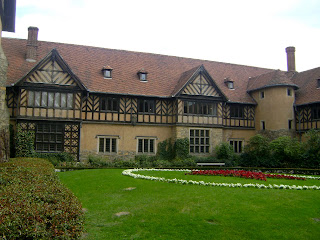On Friday, my fellow classmates and I had to attend an almost all-day excursion to Potsdam. I grudgingly went, confident that I would leave soon after checking in, due to a week's worth of sleep deprivation and a long night of partying. Many factors reinforced this preconceived plan: For starters, it was once again gray and cold in the Berlin region, and the thought of being too tired to see straight while attempting to battle the cold was enough to justify why my presence would not be necessary.
However, after chatting with some friends, and walking to our first activity of the day, I decided I would wait until after lunch to leave. "Why," I thought to myself, "would I leave before seeing the Schloss Sanssouci, the palace that Frederick the Great had designed himself?" That first thought of hesitance led to many more for the remainder of the day. Before I knew it, we had just finished a brief tour of the Cecilienhof (where the Potsdam Conference was held) and it was now 4pm. Somehow I had managed to get through the day, with a smile on my face and a belly full of gelato (something that I have seemed to develop a reputation ["einen Ruf", auf Deutsch] for).
Potsdam, for those of you who are unfamiliar with the city, is the capital of the German federal state, Brandenburg. It is located approximately 40 minutes via train away from Berlin Mitte. It is the city where the Prussian royalty decided to set up their residence until 1918. I had the pleasure of going on a tour of Schloss Sanssouci (the summer palace of Frederick the Great) and the Cecilienhof (a palace that hosted the Potsdam Conference of July 17-August 2, 1945).
The tour of Schloss Sanssouci was spectacular for many reasons. First, many of us agreed that our tour guide was one of the best tour guides that any of us have ever had. He was a pleasant, young German fellow who told humorous jokes and recited effective quotes in addition to his plethora of historical knowledge of Potsdam and the Prussian royalty. The tour guide told us how Frederick the Great did not want the palace to be built until he returned from war because he did not see any sense of a summer palace if he were to die before his return. Second, the palace was exquisite--not too lavish, but not too plain. It was the perfect combination of luxury and simplicity. It is obvious that Frederick the Great really did put a lot of thought behind what his summer palace would look like and function as. Third, the gardens revealed an array of knowledge of both the reputation of the Prussian royalty and of Frederick the Great himself. For example, they continue to plant only flowers in the garden that were present during the time of Frederick the Great. They also buried Frederick the Great in front of a semi-circle of six important philosophers throughout history, and since 6 is an unlucky number, they regard the body of Frederick the Great as the 7th, since, he, too, is seen as a great philosopher and lover of the arts.
After the tour of Schloss Sanssouci, we were given 2.5 hours to eat lunch and explore the city ourselves. We ate lunch and went into shops in the Old Town. Afterward, we walked around and saw Potsdam's version of the Brandenburg Gate and its Dutch Quarter, as well as a few churches in the area.
Then we took the tram and a bus to Cecilienhof, where we had an unexciting and brief tour of the palace. Apparently it was the last palace to be built by the Hohenzollern family (the noble family of Prussia). In modern times it served as the location for the Potsdam Conference, which is the conference where the three major players (Churchill, Truman, and Stalin) discussed what would they would do with the fallen and defeated Germany. The tour guide discussed how influential Stalin was to the layout of the conference, which is why many of the rooms in the palace were renovated. Because Stalin feared that the two democratic societies (the US and Great Britain) would scheme while he was away, he made sure to house them in divided parts of the palace, in which they had to enter and exit through their own personal doors. Moreover, Stalin did not want any power to have an unequal footing, thus he ensured that the chairs for the three heads in the conference room had engravings that would be indicative of the person's head position. Each nation's flag was also found at the center of the table and it faced in the direction of the head's respective chair/seating position around the round table.














No comments:
Post a Comment